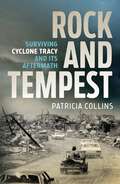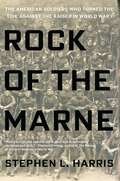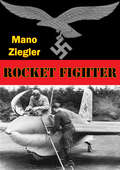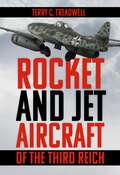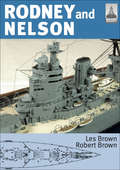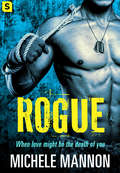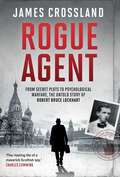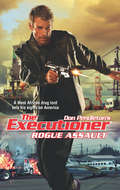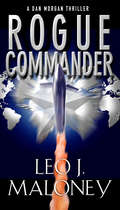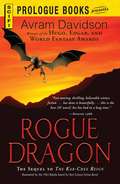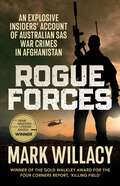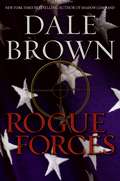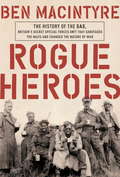- Table View
- List View
Rock Island Arsenal (Images of America)
by George EatonIn July 1862, Pres. Abraham Lincoln signed legislation to create Rock Island Arsenal, envisioning a supply and maintenance facility. After the Civil War, Rock Island became home to a great national arsenal. It made everything soldiers needed and supplied saddles, rifles, canteens, haversacks, artillery, tanks, and ammunition to the Army on the frontier and around the world. Rock Island Arsenal, located on an island in the Mississippi River, has long been the center of the local Illinois-Iowa community and the largest employer in the area. Beginning as a modest wooden fort, the arsenal grew to become the largest public-works project of the 19th century, the home of a National Historic Landmark, and the host of numerous historical events. Rock Island Arsenal still bustles as a center of Army logistics and is critical to sustaining the nation's armed forces in peace and war.
Rock and Tempest: Surviving Cyclone Tracy and its Aftermath
by Patricia CollinsWhen Cyclone Tracy flattened Darwin on Christmas Day 1974, it was the worst natural disaster Australians had ever experienced. Stationed in the city with the Women's Royal Australian Naval Service, Patricia Collins not only lived through Tracy but was part of the massive clean-up effort. This is her extraordinary story. The experience of living through a terrifying natural disaster is chillingly told by Collins as she recounts her own dark hours that Christmas, along with those of her contemporaries. They sat huddled in doorways and bathtubs as the winds raged, lifting off roofs, picking up cars and sinking ships. Most of the city was destroyed. Seventy-one people died.The Navy suffered terrible losses. A patrol boat was sunk with the loss of two crewmen and another was driven onto rocks. A sailor lost his wife and two children, and another lost his young son.In the days after Tracy, the majority of Darwin's population was evacuated interstate as the Navy's Task Force arrived to clean up and rebuild. Collins was there as a survivor of Tracy and now an integral part of the recovery.Rock and Tempest contains astonishing first-person accounts of terror and uncertainty as well as courage and survival. It is fascinating and moving, and absolutely essential reading.
Rock of the Marne
by Stephen L. HarrisThe stirring account of the Third U.S. Infantry Division in the Second Battle of the Marne--where the tide of World War I was finally turned...The soldiers of the Third U.S. Infantry Division in World War I were outnumbered and inexperienced young men facing hardened veterans, but their actions proved to be a turning point during the last German offensive of World War I.In stopping three German divisions from crossing the Marne River, these heroic American soldiers blocked the road to Paris east of Château-Thierry, helped save the French capital and, in doing so, played a key role in turning the tide of the war. The Allies then began a counteroffensive that drove the enemy back to the Hindenburg Line, and four months later the war was over.Rock of the Marne follows the Third Division's Sixth Brigade, which took the brunt of the German attack. The officers, many of them West Pointers and elite Ivy Leaguers, fighting side-by-side with enlisted men--city dwellers and country boys, cowboys and coal miners who came from every corner of America along with newly planted immigrants from Europe--answered their country's call to duty.This is the gripping true account of one of the most important--yet least explored--battles of World War I.INCLUDES PHOTOS
Rock of the Marne: The American Soldiers Who Turned the Tide Against the Kaiser in World War I
by Stephen L. HarrisThe stirring account of the Third U.S. Infantry Division in the Second Battle of the Marne--where the tide of World War I was finally turned...The soldiers of the Third U.S. Infantry Division in World War I were outnumbered and inexperienced young men facing hardened veterans, but their actions proved to be a turning point during the last German offensive of World War I.In stopping three German divisions from crossing the Marne River, these heroic American soldiers blocked the road to Paris east of Château-Thierry, helped save the French capital and, in doing so, played a key role in turning the tide of the war. The Allies then began a counteroffensive that drove the enemy back to the Hindenburg Line, and four months later the war was over.Rock of the Marne follows the Third Division's Sixth Brigade, which took the brunt of the German attack. The officers, many of them West Pointers and elite Ivy Leaguers, fighting side-by-side with enlisted men--city dwellers and country boys, cowboys and coal miners who came from every corner of America along with newly planted immigrants from Europe--answered their country's call to duty.This is the gripping true account of one of the most important--yet least explored--battles of World War I.INCLUDES PHOTOS
Rockefeller “Internationalist”: The Man Who Misrules the World
by Emanuel M. JosephsonIn Rockefeller “Internationalist”: The Man Who Misrules the World, which was first published in 1952, author Emanuel M. Josephson purports to expose the global conspiracy between the Rockefeller family and the Axis powers. Alleging that the Rockefeller Institute of Pacific Relations controlled the spy ring responsible for the attack on Pearl Harbor, the author goes to great lengths to describe the links between the Rockefellers and companies such as IG Farben, which supported Hitler’s concentration camps, as well as links between the Rockefeller family and Stalin in an effort to establish a global society.An interesting and important historical document.
Rocket Fighter
by Alexander Vanags Mano ZieglerBAPTISM OF FIRE: THE WORLDS FIRST ROCKET-POWERED JET FIGHTER.The Messerschmitt 163 was developed and tested by the Germans in absolute secrecy. As World War II drew to a close and Allied bomber formations swept across the German countryside, the Luftwaffe high command pinned its last desperate hopes on this deadly new flying machine. Although the plane came too late for Germany, it forever altered the face of war. Mano Ziegler, one of the few men to survive the Me 163’s initiation in battle, tells the story of the brave pilots pushed to the limits of physical endurance men who, bound by duty and driven by courage, experienced high-altitude velocities and air pressures no human body had ever before endured. He also tells the story of the plane itself, which screwed across the sky at unheard of speeds to usher in the age of supersonic flight and of supersonic fighters.-Print ed.
Rocket and Jet Aircraft of the Third Reich
by Terry C TreadwellThroughout much of the Second World War the Nazis’ military technology was far more advanced than anything the Allies could produce. Part of the German arsenal were rocket and jet aircraft, the first of which, the Heinkel He 178, first took to the air on 27 August 1939. It was followed by other icons of aviation such as the Messerschmitt Me 262 that had an engine with a thrust of 1,350lbs, and the famous V-1 (Doodlebug), over 9,500 of which were fired at Britain resulting in 22,892 casualties. In Rocket and Jet Aircraft of the Third Reich, aviation historian Terry C. Treadwell tells the story of the planes and weaponry that represented the cutting edge of aviation technology. He details their design, development and application and the struggles of those who built them. The German scientists and engineers were always under pressure from the German High Command during the conflict, and as it drew to a close they were caught between the Allies who wished to control them, and the SS who would stop at nothing to prevent them falling into Allied hands. Complimented by over 200 illustrations, Rocket and Jet Aircraft of the Third Reich provides unrivalled insight into the aircraft that made Germany an almost indomitable enemy.
Rocks and Rifles: The Influence of Geology on Combat and Tactics during the American Civil War (Advances in Military Geosciences)
by Scott HippensteelThis book discusses the relationship between geology and fighting during the American Civil War. Terrain was largely determined by the underlying rocks and how the rocks weathered. This book explores the difference in rock type between multiple battlegrounds and how these rocks influenced the combat, tactics, and strategies employed by the soldiers and their commanding officers at different scales.
Rocky Mountain Manhunt (Colorado Crime Consultants #2)
by Cassie MilesRESCUED BY A MOUNTAIN MAN...When Kate Carradine woke up in the woods with no memories of who or where she was, only one thing was clear: someone was trying to kill her-and she had to go into hiding. Then suddenly, a sexy stranger materialized, offering his protection.Charged with rescuing a wealthy socialite who’d gone missing, rugged outdoorsman Liam MacKenzie never expected to find a wildly sexy woman surviving in the wilderness. He vowed to keep Kate safe, but as the killers closed in, their only hope for survival rested in finding the truth buried in Kate’s shaky memory....
Rocky Mountain Peril
by Cindi Myers Carol EricsonA dangerous reunionMountain Ranger Recon by Carol Ericson Nearly three years ago, Ian Dempsey left his wife, Meg, behind to complete an undercover mission. Now, before he can explain his reasons for walking away, shots ring out and Meg&’s life is in danger. And whether Meg likes it or not, he won&’t leave her side until he can guarantee her safety, and the safety of her two-year-old son. A boy who looks exactly like Ian…Rocky Mountain Revenge by Cindi Myers Despite a new identity, Anne Gardener has been found by the one person who hurt her the most: FBI agent Jake Westmoreland. Jake doesn't have much time to restore Anne's faith in him. He needs her help to locate her mob-boss father and put him away for good. Now Jake must keep the woman he loves safe—even if it means walking into the lion's den… Previously published as Mountain Ranger Recon and Rocky Mountain Revenge
Rodney and Nelson (ShipCraft #23)
by Robert Brown Les Brown&“Simply the best reference for any model maker&” on the most instantly recognizable British battleships in history (Warship World). The ShipCraft series provides in-depth information about building and modifying model kits of famous warship types. Lavishly illustrated, each book takes the modeler through a brief history of the subject class, highlighting differences between sisterships and changes in their appearance over their careers. This includes paint schemes and camouflage, featuring color profiles and highly detailed line drawings and scale plans. The modeling section reviews the strengths and weaknesses of available kits, lists commercial accessory sets for super-detailing of the ships, and provides hints on modifying and improving the basic kit. This is followed by an extensive photographic survey of selected high-quality models in a variety of scales, and the book concludes with a section on research references—books, monographs, large-scale plans and relevant websites. The two ships covered in this volume were the only capital ships designed and built between the wars—a special concession of the Washington Treaty&’s ban on new battleships—and they were unlike anything before them, with the superstructure three-quarters aft and all main armament turrets forward of the bridge. During the war, Nelson survived mine and torpedo damage, while Rodney played a major part in the destruction of the Bismarck, both surviving to be broken up post-war.
Roer River Battles: Germany's Stand at the Westwall, 1944–45
by David R. HigginsAn account of the ups and downs of a six-month-long WWII campaign with &“a well detailed chronological order of the battles [and] interesting photographs&” (Armorama). A selection of the Military Book Club. Following the Allied breakout from the Normandy beachhead in July 1944, the vaunted German Army seemed on the verge of collapse. As British and US forces fanned out across northwestern France, enemy resistance unexpectedly dissolved into a headlong retreat to the German and Belgian borders. In early September, an elated Allied High Command had every expectation of continuing their momentum to cripple the enemy&’s warmaking capability by capturing the Ruhr industrial complex and plunging into the heart of Germany. After a brief pause to allow for resupply, Courtney Hodge&’s First Army prepared to punch through the ominous but largely outdated Westwall, the Siegfried Line, surrounding Aachen. But during the lull, German commanders such as the &“lion of defense,&” Walter Model, reorganized depleted units and mounted an increasingly potent defense. Though the German Replacement Army funneled considerable numbers to the front, they too often strained an overburdened supply system and didn&’t greatly enhance existing combat formations. More importantly, the panzer divisions, once thought irretrievably destroyed, were resupplied and reinvigorated. When the Allied offensive resumed, it ran into a veritable brick wall—gains measured in yards, not miles, if any were made at all. While both sides suffered equally in an urbanized environment of pillbox-infested hills, impenetrable forests, and freezing rain, the Germans were on the defensive and better able to inflict casualties out of proportion to their own. For the US First Army, what was originally to be a walk-through turned into a frustrating six-month campaign that decimated infantry and tank forces alike. The &“broad front,&” as opposed to a &“Schwerpunkt&” strategy, led to the demise of many a citizen-soldier. Drawing on primary Wehrmacht and US sources, including battle analysis and daily situation and after-action reports, The Roer River Battles provides insight into the desperate German efforts to keep a conquering enemy at the borders of their homeland. Tactical maps down to battalion-level help clarify the very fluid nature of the combat. Combined, they serve to explain not just how, but why decisions were made and events unfolded, and how reality often differed from doctrine in one of the longest US campaigns of World War II.
Roger Casement's Diaries: 1910:The Black and the White
by Roger SawyerBorn in Ireland in 1864 Roger Casement acted as British Consul in various parts of Africa (1895-1904) and Brazil (1906-11) where he denounced atrocities among Congolese and Putumayo rubber workers. knighted in 1911, He returned to Ireland, where as an ardent nationalist he attempted to enlist German help for the cause. He was hanged for high treason in London in 1916. A compulsive diary writer, his so-called 'Black' Diaries were finally released into the public domain in 1994. At the time of his trial, these diaries-detailing his promiscuous homosexual activities in Brazil-were used to condemn him and, subsequently, to poison his reputation. Published here for the first time-as are his more public 'White' Diaries of the same year-they not only offer the reader the opportunity to judge their authenticity-still a matter of heated debate-but they also take us deep into the mind of the bravest, most selfless and practical humanitarian of the Edwardian age.
Roger So Far ...: The first 100 years of the Royal Corps of Signals
by Royal Corps of SignalsTHE OFFICIAL CENTENARY BOOK FOR THE CORPS OF ROYAL SIGNALS, FULLY ILLUSTRATED THROUGHOUT Since 1920, the Royal Corps of Signals has provided the British Army’s central nervous system, enabling orders to be delivered and information to be exchanged, principally at the higher levels of command. It has been crucial in supporting the vast majority of military land-based operations after the First World War. Its importance is growing because conducting successful operations is becoming increasingly reliant upon being able to operate in a congested and contested electronic battlespace. ROGER SO FAR does not aim to tell the full story of the Royal Corps of Signals, since much of the Corps’ work now and in the past is secret. Instead the book is a celebration of the Corps’ achievements and the ability of its soldiers to use innovation and improvisation to deliver results beyond all reasonable expectations. As well as acting as an historical record, including reminiscences covering several aspects of life within the Corps during its first 100 years, it seeks to stir memories and to inform those who are serving, or have served in the Corps, as well as to inform those who have not served and those who may be thinking of doing so. Recommended for large e-reader screens in colour
Roger, Sausage and Whippet: A Miscellany of Trench Lingo from the Great War
by Christopher MooreRoger: A code word for a gas cylinder and a nickname for rum. Sausage: An observation balloon. Whippet: A small, light type of tank with a top sped of eight m.p.h. The First World War raged for four years, taking with it hundreds of thousands of young soldiers who lived and died together, bonded by the horror of the war. Now, all the way from the trenches and through the letters of Christopher Moore's Captain Cartwright, comes an extraordinary lexicon of the phrases and lingo of life at the front. Whether born from the desperation of gallows humour ('If it keeps on like this, someone's going to get hurt'), borrowed from Cockney rhyming slang, Latin, French and other languages ('Cushy: Comfortable, safe, pleasant. From the Hindustani: khush, pleasure') or even taken from the name of the Huntley and Palmer biscuit company, Tommy had a new word for almost everything. From Ammo to Zig-Zag, this is a fascinating glimpse into the world of our First World War heroes. So fetch the dooly and the other makings, brew up some char, and read on safe in the knowledge that you won't be going over the top today...
Roger, Sausage and Whippet: A Miscellany of Trench Lingo from the Great War
by Christopher MooreRoger: A code word for a gas cylinder and a nickname for rum. Sausage: An observation balloon. Whippet: A small, light type of tank with a top sped of eight m.p.h. The First World War raged for four years, taking with it hundreds of thousands of young soldiers who lived and died together, bonded by the horror of the war. Now, all the way from the trenches and through the letters of Christopher Moore's Captain Cartwright, comes an extraordinary lexicon of the phrases and lingo of life at the front. Whether born from the desperation of gallows humour ('If it keeps on like this, someone's going to get hurt'), borrowed from Cockney rhyming slang, Latin, French and other languages ('Cushy: Comfortable, safe, pleasant. From the Hindustani: khush, pleasure') or even taken from the name of the Huntley and Palmer biscuit company, Tommy had a new word for almost everything. From Ammo to Zig-Zag, this is a fascinating glimpse into the world of our First World War heroes. So fetch the dooly and the other makings, brew up some char, and read on safe in the knowledge that you won't be going over the top today...
Rogue
by Michele MannonMy lover is dead.And they think I killed him.I'm running rogue. Hell bent on both revenge and redemption. Whatever it takes, I'm going to finish a job that began nine months ago. An unauthorized assignment that turned horribly, devastatingly wrong. My miscalculation. My fault. My heart left shattered into incomplete pieces which will never wholly fit back together again.But first I have to outsmart my former organization and the hired killer they've sent after me; a killer who knows my every move, who's been inside my head, my heart, and my dreams. I'm the traitor, Kylie. The rogue mercenary. Jaxson's newest assignment. And this is our love story.
Rogue Agent: From Secret Plots to Psychological Warfare: The Untold Story of Robert Bruce Lockhart
by James CrosslandTaking the reader on a colorful journey from the Russian Revolution through both world wars, this is the story of "the riveting life of maverick spy&” Robert Bruce Lockhart.Diplomat, conspirator, intelligence gatherer, propagandist, and charmer, Rogue Agent tells the colorful story of London&’s key agent in Moscow during the first half of the twentieth century, Sir Robert Bruce Lockhart. Sir Robert Bruce Lockhart (1887–1970) was an impressive figure who played a vital role in both world wars. He was a man who charmed his way into the confidences of everyone from Leon Trotsky to Anthony Eden. A man whom the influential press baron Lord Beaverbrook claimed, "could well have been prime minister.&” And yet Lockhart died almost forgotten and near destitute, a Scottish footnote in the pages of history. Rogue Agent is the first biography of this gifted yet habitually flawed maverick. It chronicles his many exploits, from his time as Britain&’s agent in Moscow and his role in a plot to bring down the communist regime to his leadership in the Political Warfare Executive—a secret body responsible for disinformation and propaganda during World War II. Exploring Lockhart&’s unorthodox thinking and contributions to the development of psychological warfare, as well as his hedonistic lifestyle, late nights, and many affairs that left him in a state of perpetual debt and emotional turmoil, Rogue Agent presents the thrilling and dramatic tale of this unconventional war hero.
Rogue Assault
by Don PendletonNARCO SOLUTION Africa's first narco-state, Guinea-Bissau, has become a powerful transhipment point for Colombian and Mexican cartels. But when the country's traffickers work their way into the U.S. and DEA officers are killed trying to take them down, the President decides it's time to put an end to the illicit trade.Mack Bolan is unable to legally confront the drug kingpin of the country, so his mission is to go in under the radar and clean house. Striking the drug factories one by one and dodging bullets at every turn, Bolan soon learns that everyone-from the corrupt leaders in the military to the police department-is part of the drug ring. There's only one way justice can be served, and the Executioner is determined to be the last man standing.
Rogue Commander (A Dan Morgan Thriller #5)
by Leo J. MaloneyFrom a Black Ops veteran and author of Termination Orders comes a nonstop thrill ride straight into the secret world of covert agents. Rogue Commander Four-star general James Collins has been accused of stealing a cache of Tomahawk missiles—and reaches out to his friend, CIA veteran Dan Morgan, for help. But Morgan is playing with fire. The Zeta Division, chasing down a black-market middleman, discovers a connection to a North Korean military officer—and one of his team winds up a prisoner in Pyongyang. As Morgan takes a series of escalating risks, it becomes clear that a global plot is already in motion—and if they can&’t stop it, an unimaginable number of innocent civilians will be slaughtered…Praise for Leo J. Maloney and His Novels&“Utterly compelling! Dan Morgan is one of the best heroes to come along in ages.&”—Jeffery Deaver&“The new master of the modern spy game.&”—Mark Sullivan&“Fine writing and real insider knowledge.&”—Lee Child &“Everything a thriller reader wants.&”—Ben Coes &“A ripping story!&”—Meg Gardiner &“Rings with authenticity.&”—John Gilstrap
Rogue Dragon: The Sequel to The Kar-Chee Reign
by Avram DavidsonPrime World: Home of the Universe’s Most Elite Dragon HuntGenerations after Liam and his tribe defend Britland from the Devils that threatened Earth, new danger stalks on her forests and rebuilt cities.The Hunt Corporation has turned the remote, nearly forgotten Prime World into a game preserve. Far away from the meddling of the Confederation, the rich and carefree have turned the tables on their enemies of old. The prey: the dragons of the Kar-Chee. But the locals-descendents from the same humans who fought off the insect-like dragon masters a few hundred years before-are far from satisfied with the new ruling class. Violent and angry, they protect secrets and conspiracies that could bring the Hunt Corporation to its knees . . . or turn Prime World into another feudal playground for centuries to come.
Rogue Forces
by Mark WillacyRogue Forces is the explosive first insiders&’ story of how some of Australia&’s revered SAS soldiers crossed the line in Afghanistan, descending from elite warriors to unlawful killers. Mark Willacy, who won a Gold Walkley for exposing SAS war crimes, has penetrated the SAS code of silence to reveal one of the darkest chapters in our country&’s military history. Willacy&’s devastating award-winning Four Corners program, &‘Killing Fields&’ captured on film for the first time a war crime perpetrated by an Australian: the killing of a terrified, unarmed Afghan man in a field by an SAS soldier. It caused shockwaves around the world and resulted in an Australian Federal Police war crimes investigation. It also sparked a new line of investigation by the Brereton inquiry, the independent Australian Defence Force inquiry into war crimes in Afghanistan. It was a game changer. But for Willacy, it was just the beginning of a much bigger story. More SAS soldiers came forward with undeniable evidence and eyewitness testimony of other unlawful killings, and exposed a culture of brutality and impunity. Rogue Forces takes you out on the patrols where the killings happened. The result is a gripping character-driven story that embeds you on the front line in the thick of the action as those soldiers share for the first time what they witnessed. Willacy also confronts those accused about their sides of the story. At its heart, Rogue Forces is a story about the true heroes who had the courage to come forward and expose the truth. This is their story. A story that had to be told.
Rogue Forces (Patrick McLanahan Series #15)
by Dale BrownThe clash of civilizations will be won . . . by the highest bidder. What happens when America's most lethal military contractor becomes uncontrollably powerful? His election promised a new day for America . . . but dangerous storm clouds are on the horizon. The newly inaugurated president, Joseph Gardner, pledged to start pulling U.S. forces out of Iraq on his first day in office--no questions asked. Meanwhile, former president Kevin Martindale and retired Air Force lieutenant-general Patrick McLanahan have left government behind for the lucrative world of military contracting. Their private firm, Scion Aviation International, has been hired by the Pentagon to take over aerial patrols in northern Iraq as the U.S. military begins to downsize its presence there. Yet Iraq quickly reemerges as a hot zone: Kurdish nationalist attacks have led the Republic of Turkey to invade northern Iraq. The new American presi dent needs to regain control of the situation--immediately--but he's reluctant to send U.S. forces back into harm's way, leaving Scion the only credible force in the region capable of blunting the Turks' advances. But when Patrick McLanahan makes the decision to take the fight to the Turks, can the president rein him in? And just where does McLanahan's loyalty ultimately lie: with his country, his commander in chief, his fellow warriors . . . or with his company's shareholders? In Rogue Forces, Dale Brown, the New York Times bestselling master of thrilling action, explores the frightening possibility that the corporations we now rely on to fight our battles are becoming too powerful for America's good.
Rogue Heroes: The History of the SAS, Britain's Secret Special Forces Unit That Sabotaged the Nazis and Changed the Nature of War
by Ben MacintyreThe latest from the bestselling author of Operation Mincemeat and A Spy Among Friends -- the untold story of one of WWII's most important secret military units.Ben Macintyre's latest book of derring-do and wartime intrigue reveals the incredible story of the last truly unsung secret organization of World War II -- Britain's Special Air Service, or the SAS. Facing long odds and a tough slog against Rommel and the German tanks in the Middle East theatre, Britain turned to the brainchild of one its most unlikely heroes -- David Stirling, a young man whose aimlessness and almost practiced ennui belied a remarkable mind for strategy. With the help of his equally unusual colleague, the rough-and-tumble Jock Lewes, Stirling sought to assemble a crack team of highly trained men who would parachute in behind enemy lines to throw monkey wrenches into the German war machine. Though he faced stiff resistance from those who believed such activities violated the classic rules of war, Stirling persevered and in the process created a legacy. Staffed by brilliant, idiosyncratic men whose talents defied both tradition and expectations, the SAS would not only change the course of the war, but the very nature of combat itself. Written with complete access to the never-before-seen SAS archives (who chose Macintyre as their official historian), Rogue Heroes offers a powerfully intimate look at life on the battlefield as lived by a group of remarkable soldiers whose contributions have, until now, gone unrecognized beyond the classified world. Filled with wrenching set pieces and weaving its way through multiple theatres of our grandest and most terrible war, this book is both an excellent addition to the Macintyre library and a critical piece in our understanding of the war's unfolding.
Rogue Heroes: The History of the SAS, Britain's Secret Special Forces Unit That Sabotaged the Nazis and Changed the Nature of War
by Ben MacintyreNEW YORK TIMES BESTSELLER • The incredible untold story of World War II&’s greatest secret fighting force, as told by the modern master of wartime intrigue—now an original series on MGM+!&“Reads like a mashup of The Dirty Dozen and The Great Escape, with a sprinkling of Ocean&’s 11 thrown in for good measure.&”—Michiko Kakutani, The New York TimesONE OF NPR&’S BEST BOOKS OF THE YEAR • &“Rogue Heroes is a ripping good read.&”—Washington Post (10 Best Books of the Year)Britain&’s Special Air Service—or SAS—was the brainchild of David Stirling, a young aristocrat whose aimlessness belied a remarkable strategic mind. Where most of his colleagues looked at a World War II battlefield map and saw a protracted struggle, Stirling saw an opportunity: given a small number of elite men, he could parachute behind Nazi lines and sabotage their airplanes and supplies. Defying his superiors&’ conventional wisdom, Stirling assembled a revolutionary fighting force that would upend not just the balance of the war, but the nature of combat itself.Bringing his keen eye for detail to a riveting wartime narrative, Ben Macintyre uses his unprecedented access to the SAS archives to shine a light on a legendary unit long shrouded in secrecy.

